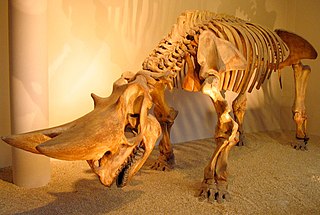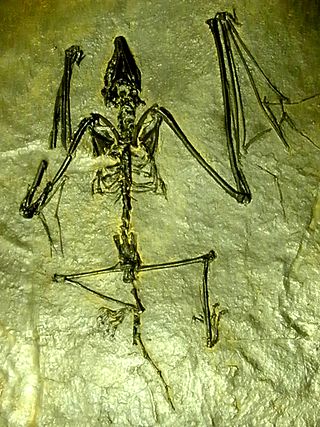
Arsinoitherium is an extinct genus of paenungulate mammals belonging to the extinct order Embrithopoda. It is related to elephants, sirenians, and hyraxes. Arsinoitheres were superficially rhinoceros-like herbivores that lived during the Late Eocene and the Early Oligocene of North Africa from 36 to 30 million years ago, in areas of tropical rainforest and at the margin of mangrove swamps. A species described in 2004, A. giganteum, lived in Ethiopia about 27 million years ago.

Hyaenodon ("hyena-tooth") is an extinct genus of carnivorous placental mammals from extinct tribe Hyaenodontini within extinct subfamily Hyaenodontinae, that lived in Eurasia and North America from the middle Eocene, throughout the Oligocene, to the early Miocene.

Palaeochiropteryx is an extinct genus of bat from the Middle Eocene of Europe and North America. It contains three very similar species – Palaeochiropteryx tupaiodon and Palaeochiropteryx spiegeli, both from the famous Messel Pit of Germany, as well as Palaeochiropteryx sambuceus from the Sheep Pass Formation. They are usually found complete and exceptionally preserved, even retaining the outlines of their fur, ears, and wing membranes.
Witwatia is an extinct genus of giant bat that contained two species which lived in the Al Fayyum in Egypt during the late Eocene and one species which lived in Tunisia during the early Eocene. It is known from a lower jaw and teeth. Three species have been named: the type species W. schlosseri, W. eremicus and W. sigei.

Archaeonycteris is an archaic bat genus whose fossilised remains have been found in Germany, France, England and India.

The Jebel Qatrani Formation is a geologic formation located in the Faiyum Governorate of central Egypt. It is exposed between the Jebel Qatrani escarpment and the Qasr el Sagha escarpment, north of Birket Qarun lake near Faiyum. The formation conformably overlies the Qasr el Sagha Formation and is topped by the Widan el Faras Basalt. The age of the formation has been subject to debate, but the most recent research indicates that it covers both the latest parts of the Eocene and the Early Oligocene, spanning over the boundary between these two time periods.

Pterodon is an extinct genus of hyaenodont in the family Hyainailouridae, containing five species. The type species Pterodon dasyuroides is known exclusively from the late Eocene to the earliest Oligocene of western Europe. The genus was first erected by the French zoologist Henri Marie Ducrotay de Blainville in 1839, who said that Georges Cuvier presented one of its fossils to a conference in 1828 but died before he could make a formal description of it. It was the second hyaenodont genus with taxonomic validity after Hyaenodon, but this resulted in taxonomic confusion over the validities of the two genera by other taxonomists. Although the taxonomic status of Pterodon was revised during the late 19th and early 20th centuries, it became a wastebasket taxon for other hyaenodont species found in Africa and Asia. Today, only the type species is recognized as belonging to the genus while four others are pending reassessment to other genera.

Palaeochiropterygidae is a family of extinct bats. It was originally erected by the Swiss naturalist Pierre Revilliod in 1917 after discoveries of Palaeochiropteryx fossils from the Messel Pit of Germany. Palaeochiropterygidae was merged into Archaeonycteridae by Kurten and Anderson in 1980, but modern authorities specializing in bat fossils maintain the distinction between the two. It was classified to the unranked clade Microchiropteramorpha by Smith et al. in 2007.

Afrotarsius is a primate found in the Paleogene of Africa.
This paleomammalogy list records new fossil mammal taxa that were described during the year 2012, as well as notes other significant paleomammalogy discoveries and events which occurred during that year.
This paleomammalogy list records new fossil mammal taxa that were described during the year 2010, as well as notes other significant paleomammalogy discoveries and events which occurred during that year.

Necromantis is an extinct genus of bat that lived during the Eocene. Its fossils are found in the Quercy Phosphorites Formation of France and the Djebel Chambi in Tunisia. Specimens of Necromantis are notable for their large size and specialization towards a predatory lifestyle.
Dizzya is an extinct, monotypic genus of bat that occurred in the Chambi region, Tunisia, in the Middle Eocene. It was described based on a single upper molar, a lower dentary with two broken teeth, and a humerus. It is the smallest and, along with Witwatia sigei, the oldest representative of the Philisidae, an extinct family of bats related to the Vespertilionidae.
Matthesia was a primitive bat genus in the family Palaeochiropterygidae. Matthesia is represented by two species known from the middle Lutetian of Geiseltal, Germany. It may be a junior synonym of Palaeochiropteryx.
Aegyptonycteris is a genus of extinct bat from the Late Eocene of North Africa. It is currently known from a single specimen from the Birket Qarun Formation in the Fayum Depression in western Egypt.

Hesham Sallam is an Egyptian paleontologist and the founder of the Mansoura University Vertebrate Paleontology Center (MUVP-C), the first vertebrate paleontology program in the Middle East. He works as an associate professor at the American University in Cairo and Mansoura University. Sallam led the discovery and description of Mansourasaurus shahinae, a species of sauropod dinosaur from Egypt, which has improved understanding of the prehistory of Africa during the latest Cretaceous period. His work has helped popularize paleontology in Egypt.
Propotto is an extinct monotypic genus of strepsirrhine primate from the early Miocene of Kenya. It contains one described species, Propotto leakeyi. Although long considered a pteropodid fruit-eating bat after spending a brief sojourn as a prehistoric relative of lorises, recent research shows it to be an extinct relative of the aye-aye.
Wyonycteris is a genus of small mammals that existed in the late Paleocene and early Eocene epochs. The type species is Wyonycteris chalix, which lived in Wyoming during the Clarkforkian North American Land Mammal Age of the Paleocene and was originally proposed to be an early form of insectivorous bat. Later re-examination of the material has put this alliance in doubt, and the genus has instead been proposed as belonging to the subfamily Placentidentinae, within the family Nyctitheriidae. Similar fossil material of the same time period found in Europe was later discovered and described as new species, Wyonycteris richardi.

Onychonycteridae is an extinct family of bats known only from the early Eocene of Europe and North America. The type species, Onychonycteris finneyi, was described in 2008 from two nearly complete skeletons found in the Green River Formation of southwestern Wyoming. Since that time a number of previously described fossil bat species have been assigned to Onychonycteridae, as well as two more recently discovered species.

Nyctitheriidae is a family of extinct eulipotyphlan insectivores known from the Paleocene and Eocene epochs of North America and Asia and persisting into the Oligocene of Europe. Several genera, including Nyctitherium, Paradoxonycteris, and Wyonycteris, have initially been described as bats, although the family is more frequently placed in the order Eulipotyphla.











